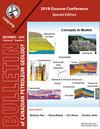The origin of low molecular weight hydrocarbons associated with biogenic gas from the Eastern Depression in Qaidam Basin, China
Q3 Earth and Planetary Sciences
引用次数: 4
Abstract
Abstract The Eastern Depression of Qaidam Basin in China is the largest Quaternary gas producing area in the world. The chemical compositions, C1–C2 carbon and hydrogen isotopic compositions, low molecular weight hydrocarbons (C6–C7LMWHs) in 10 natural gas samples from three large gas fields (Tainan, Sebei 1 and Sebei 2) in Eastern Depression of Qaidam Basin were analyzed. The carbon and hydrogen isotopic composition of methane in the three gas fields is relatively enriched in 12C and 1H with δ13C1 values ranging from −69.6 ‰ to −65.5 ‰ (average −67.4 ‰) and δ1H from −251 ‰ to −231 ‰ (average −244 ‰). The data shows that the gases are defined as microbial in origin and generated primarily by bacterial CO2 reduction. The composition distribution of C6–C7LMWHs differs between the fields. LMWHs associated with the gas in the Sebei 1 gas field are different from those in the Tainan and Sebei 2 gas fields. The relative content of cycloalkane among C6–C7LMWHs in the Tainan and Sebei 2 gas fields is very high, ranging from 37.02% to 43.36% and 33.99% to 43.71% respectively. However, in the Sebei 1 gas field, of the total C6–C7LMWHs, the relative content of isoalkane is the highest, ranging from 37.17% to 45.92% with an average of 42.48. These traits indicate that the origins of C6–C7LMWHs are probably different from the bacterial action that is predominant in the Sebei 1 gas field. We infer that catalytic reaction affects the C6–C7LMWHs compositions in the Tainan and Sebei 2 gas fields.柴达木盆地东部坳陷与生物气相关的低分子量烃的成因
中国柴达木盆地东部坳陷是世界上最大的第四系产气区。分析了柴达木盆地东部凹陷台南、涩北1、涩北2三个大气田10份天然气样品的化学组成、C1-C2碳、氢同位素组成、低分子量烃(C6-C7LMWHs)。3个气田甲烷碳、氢同位素组成相对富集于12C和1H, δ13C1值介于- 69.6‰~ - 65.5‰(平均- 67.4‰),δ1H值介于- 251‰~ - 231‰(平均- 244‰)。数据表明,这些气体被定义为微生物起源,主要由细菌二氧化碳还原产生。C6-C7LMWHs的组成分布在不同的场区有所不同。北1气田与台南气田、北2气田的伴生低分子量水相不同。台南气田和色北2气田C6-C7LMWHs中环烷烃的相对含量较高,分别为37.02% ~ 43.36%和33.99% ~ 43.71%。而色北1气田的C6-C7LMWHs中,异烷烃相对含量最高,为37.17% ~ 45.92%,平均为42.48%。这些特征表明,C6-C7LMWHs的成因可能与涩北1气田主要的细菌作用不同。推断台南气田和涩北2气田的C6-C7LMWHs组分受催化反应影响。
本文章由计算机程序翻译,如有差异,请以英文原文为准。
求助全文
约1分钟内获得全文
求助全文
来源期刊

Bullentin of Canadian Petroleum Geology
Earth and Planetary Sciences-Geochemistry and Petrology
CiteScore
2.50
自引率
0.00%
发文量
0
期刊介绍:
The Bulletin of Canadian Petroleum Geology is a peer-reviewed scientific journal published four times a year. Founded in 1953, the BCPG aims to be the journal of record for papers dealing with all aspects of petroleum geology, broadly conceived, with a particularly (though not exclusively) Canadian focus. International submissions are encouraged, especially where a connection can be made to Canadian examples.
 求助内容:
求助内容: 应助结果提醒方式:
应助结果提醒方式:


